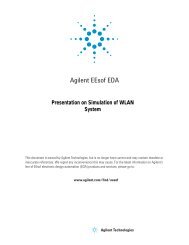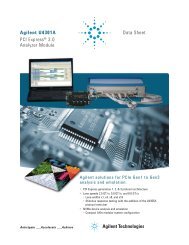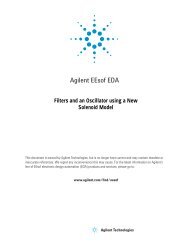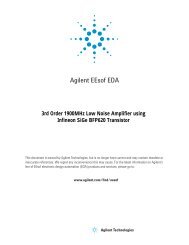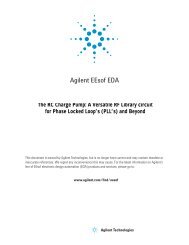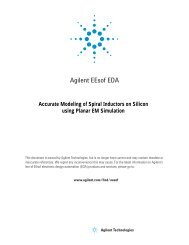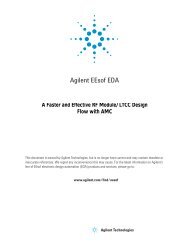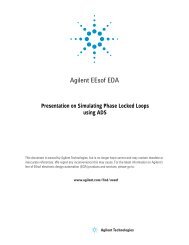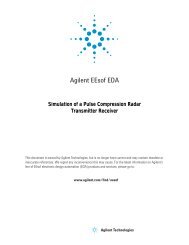Agilent 34980A Multifunction Switch/Measure Unit *34980-90005*
Agilent 34980A Multifunction Switch/Measure Unit *34980-90005*
Agilent 34980A Multifunction Switch/Measure Unit *34980-90005*
Create successful ePaper yourself
Turn your PDF publications into a flip-book with our unique Google optimized e-Paper software.
3 Features and Functions<br />
Scanning<br />
The instrument allows you to combine a DMM (either internal or external)<br />
with multiplexer channels to create a scan. During a scan, the instrument<br />
connects the DMM to the configured multiplexer channels one at a time<br />
and makes a measurement on each channel.<br />
Any channel that can be “read” by the instrument can also be included in<br />
a scan. This includes any combination of temperature, voltage, resistance,<br />
current, frequency, or period measurements on multiplexer channels. <br />
A scan can also include a read of a digital channel or a read of the<br />
totalizer count on the digital modules. Scanning is allowed with the<br />
following modules:<br />
34921A through 34925A Multiplexer Modules<br />
34950A Digital I/O Module (digital input and counter channels only)<br />
34952A <strong>Multifunction</strong> Module (digital input and totalizer channels only)<br />
Automated scanning is not allowed with the other switching modules. <br />
In addition, a scan cannot include a write to a digital channel or a voltage<br />
output from a DAC channel. You can, however, write your own program to<br />
manually create a “scan” to include these operations.<br />
Rules for Scanning<br />
Before you can initiate a scan, you must set up a scan list to include all<br />
desired multiplexer or digital channels. Channels which are not in the<br />
scan list are skipped during the scan. By default, the instrument scans<br />
the list of channels in ascending order from slot 1 through slot 8<br />
(channels are reordered as needed). If your application requires<br />
non- ordered scanning of the channels in the present scan list, see<br />
“Non- Sequential Scanning” on page 124. <strong>Measure</strong>ments are taken only<br />
during a scan and only on those channels which are included in the<br />
scan list.<br />
You can store at least 500,000 readings in memory and all readings are<br />
automatically time stamped. If memory overflows, a status register bit<br />
is set and new readings will overwrite the first (oldest) readings stored.<br />
The most recent readings are always preserved. You can read the<br />
contents of memory at any time, even during a scan. Reading memory<br />
is not cleared when you read it.<br />
Each time you start a new scan, the instrument clears all readings<br />
(including alarm data) stored in reading memory from the previous<br />
scan. Therefore, the contents of memory are always from the most<br />
recent scan.<br />
108 <strong>Agilent</strong> <strong>34980A</strong> Mainframe User’s Guide





